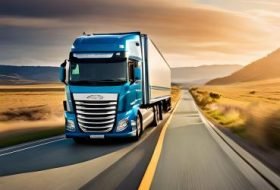If you are considering joining the trucking industry it is smart to become familiar with the different trailer categories and types that can be found on the roads throughout the United States. In order to become a truck driver, there are several factors to consider, including what type of trailer you will be working with. There are several different types of freight trailers, each with their own features and requirements. Learning about the various semi-trailers on the road will help you prepare for and select the best job for you.
Box Trailers
• The most common type of trailer is the box trailer. Just as the name suggests, the box trailer is simply an enclosed space about 8 feet wide and 9 feet high and from 28 to 53 feet long. A box trailer weighs between 10,000 and 15,000 pounds. Some box trailers feature side loading. One side of the trailer is made of reinforced waterproof fabric that can be rolled up. Box trailers often have a refrigeration unit which keeps the inside cool. Refrigerated trailers are used to haul perishable goods such as fresh fruit.
Car Carriers
• Auto transport trailers carry up to ten cars on the highway. The trucker can use an open car carrier which is about 80 feet long and 14 feet high or a closed auto transport trailer which can carry two, four or six cars. Enclosed trailers are more expensive and used only with costly cars that cannot travel exposed to the elements.
Bulk Carriers
• Trailers that carry liquid or anything dry that flows, such as sand or cement, will look alike. They have a big tank with either big pipes to offload the liquid or wide doors or hatches on the bottom that open to dump the dry load. They can carry from 1600 to 4100 cubic feet of dry or wet cargo.
Flatbed Trailers
• Flatbed trailers haul big items that will not fit inside a box trailer. As the name suggests, a flatbed trailer is a flat platform that either tilts or has extendable ramps for loading the cargo. Some flatbed trailers can be lowered to the ground once detached from the truck to make loading and unloading easier. Other flatbed trailers have a small crane at one or both ends for loading.
Livestock Trailers
• Sheep, cattle, horse and hogs travel in trailers with openings in the sides of the trailer for ventilation, pens to keep them safe and upright and special ramps for loading and unloading.
Other Trailers
• Special-purpose trailers fill needs that don’t come up very often. Bus trailers are designed just like a regular passenger bus but without the driver. They are not used in the United States. Trucks haul wallboard and other long, wide and flat materials on panel trailers which have two sloping walls that run the length of the trailer. Loads with strange shapes such as 145-foot-long windmill blades travel on purpose-built trailers that might feature two or more trailers supporting the load. Often, the rear trailer of a multi-trailer setup will be steerable.







